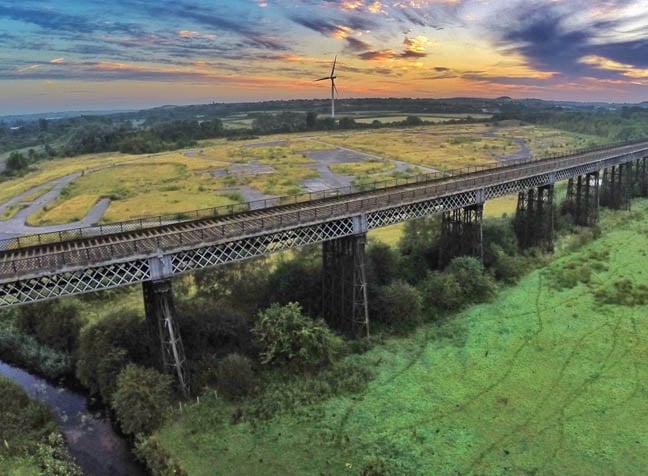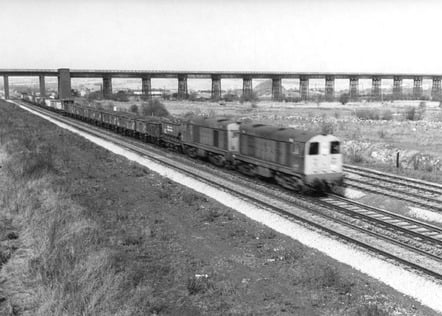This article is more than 1 year old
Fancy a viaduct? We have a wrought Victorian iron marvel to sell you
Myth, legend and the lucky escape of Bennerley
Geek's Guide to Britain The pell-mell expansion of Britain's railways in the 19th century has bequeathed some impressive feats of engineering. Great stone viaducts like those at Calstock in Cornwall and Harringworth near Melton Mowbray get the glory, but for my money it's the iron bridges that are the real marvels.
Many centuries earlier the Romans were knocking out perfectly good stone viaducts, but a delicate iron latticework bridge that looks far too insubstantial to carry a thundering locomotive and its string of carriages and wagons? That's something only the great engineers of the industrial revolution attempted.
The finest wrought-iron viaduct in England is to be found straddling the Erewash Valley at Bennerley, midway between Derby and Nottingham. Remarkably for all that industrial expansion, it's one of just two remaining such viaducts in England and a grade-II listed structure.
Why wrought iron? Wasn't this material some kind of a Victorian obsession? No. In Bennerley's case it was a practical answer to building a structure light enough to cross a valley floor riddled with earlier unmapped coal and iron workings ready to suck a heavy structure to a subsidence-ridden doom.
The resulting delicate, 16-span lattice structure is as much a unique engineering marvel as a thing of beauty.
Bennerley is some 440m (1,444ft) long and 18m (59ft) tall. Not as imposing as its Scottish counterparts the 1887 Tay and 1890 Forth railway bridges, which were built to withstand harsh estuary weather and provide ample clearance to shipping, but Bennerley was by some margin the longest of its type.
OK, let's clarify that a little. Yes, the Tay and Forth are longer, but unlike Bennerley they are not traditional Warren-style lattice spans.
Bennerley is, therefore, the longest traditional wrought-iron bridge with Warren piers and lattice or truss girder spans in Britain, rather than the longest iron bridge per se.
And while lattice-girder bridges were indeed once quite common, the only other of its kind still in existence is the much shorter, at a piffling 164.8m (541ft), Meldon Viaduct in Devon.
The Crumlin Viaduct, the first of the breed, was dismantled in 1967 (its final days recorded in the closing scenes of the 1966 Gregory Peck and Sophia Loren film Arabesque) as were two other fine examples at Belah in Westmorland and Deepdale in County Durham.
That Bennerley still stands is as much down to its size as luck. That grade-II listing in 1974 granted it some statutory protection and helped put the kibosh on the nationalised British Rail's 1975 demolition plans.
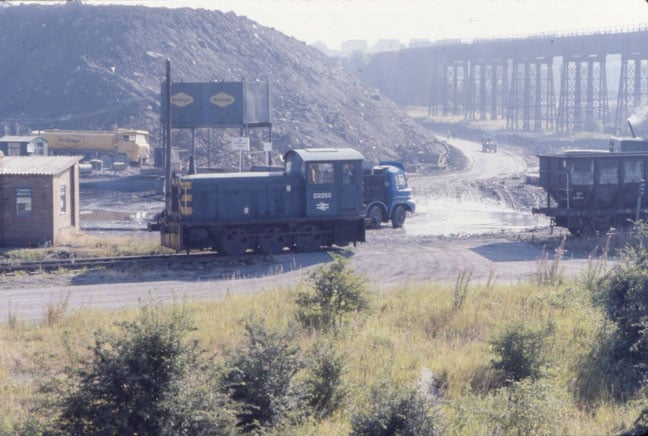
In the thick of it: Bennerley Viaduct going strong into the 20th century. Photo: Sustrans
Nearly half a century on, Bennerley promises to rise again. It's subject of a multimillion-pound renovation and revitalisation project from cycling charity Sustrans that planned to repurpose the viaduct as part of the National Cycle Network.
Curiously for such a large structure, Bennerley Viaduct is rather easy to miss – as I found out on a visit. It was a crisp winter's day and I had expected something as long and built for industry to be instantly visible from the main road. Had I not been given instructions where to park I would have driven right past. And so might you.
Parking up in a small layby on the A6096 I took a stroll along the bank of the nearby Nottingham Canal as far as the viaduct information board, a spot that affords the best panoramic view of the structure.
From there I backtracked to a public footpath that connects to a road that leads to the site of the abandoned Bennerley Coal Concentration Depot. This road also serves the nearby Severn Trent water treatment plant so is closed to public traffic. Cross the depot site and you find yourself at the foot of the viaduct's iron piers.
Given the bucolic isolation of the Erewash Valley – I only encountered some local wildlife and a solitary drone enthusiast – it is difficult to imagine that throughout the 1970s and 80s the area around the viaduct was the site of intense industrial activity.
It was during this time that first the eastern and then western approach ramps were dug away resulting in the steep and rugged ascent needed to get onto the viaduct itself today.
Despite the removal of the ramps and the structure not being technically open to the public it is still easy enough to scramble up onto the railway bed from either end and walk the full length of the viaduct. Care is needed, though, because the rail bed ballast is long since gone, a reality that necessitates stepping across the now empty troughs from girder to girder. If you cross the viaduct, you do so at your own risk.
Much of the undergrowth beneath has been cleared, especially at the western end. So, while there's no path to speak of, you can make your way without too much trouble. And make your way you should as your perseverance will be rewarded by close-up views of the wrought iron pillars and their Staffordshire blue brick and Derbyshire gritstone-encased footings.
It is this opportunity to get up close to a structure of this magnitude that has remained largely untouched for well over a century and explore it without let or hindrance that is one of the main reasons to visit the site.
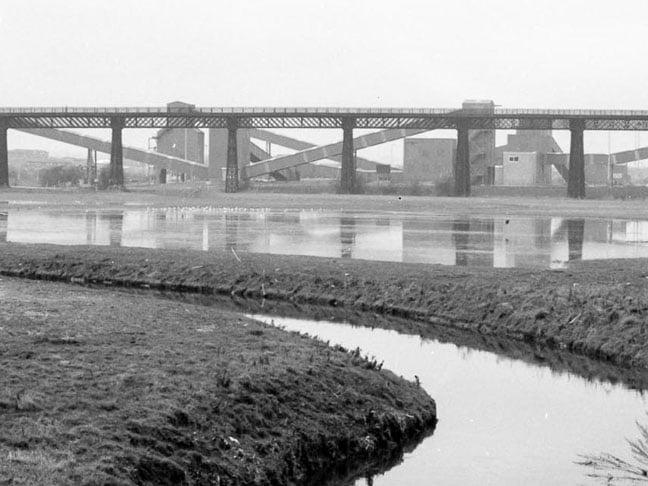
Big picture on the industrial Erewash Valley. Photo: Sustrans
I spent three hours at Bennerley and covered about three miles from the canal side to the western end of the viaduct, along the underside, up onto the eastern end, across the railway deck then back down the far end and then back to the car with a detour for lunch in the middle.
If the weather is clement the top of the viaduct makes a good place for a picnic, offering spectacular views up and down the line of the Erewash Valley. As it was a bit chilly on the day of my trip, I retired to the nearby Bridge Inn in Ilkeston for sustenance.
Work on Bennerley Viaduct started in the late 1860s when a group of local businessmen began laying plans to exploit 4,000 acres of coal-producing land on the Duke of St Albans' Bestwood estate.
The problem they faced was the local railway monopoly held by the Midland Railway Company, whose transportation costs and price fixing were regarded as little short of extortionate.
The Midland Railway Company had long been regarded as a brake on the industrial development of Derby so when local business leaders found common cause with the colliery owners of the Erewash Valley, finding a solution to the problem shot to the top of their to-do list.
Their answer was the 1872 The Great Northern Railway (Derbyshire and Staffordshire) Act that paved the way for a 40-mile network of main line and branches linking Burton-upon-Trent to Nottingham via Derby. The new Friargate station in Derby lent the new line its popular name.
Building the new network involved spending some £1.1m (£120m today), demolishing parts of Derby, navigating an inconvenient ridge northeast of Nottingham and spanning the Erewash Valley.
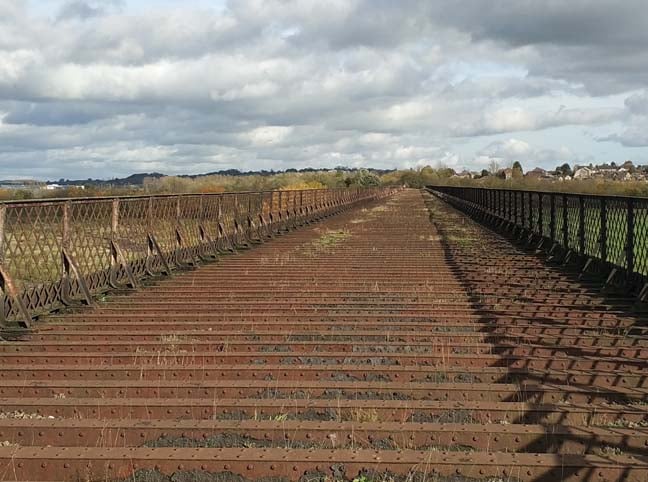
Treading in the tracks of trains atop Bennerley Viaduct. Photo: Alun Taylor
In Victorian times the first problem wasn't really a problem at all. Whole streets were simply flattened, the scars still visible on any aerial view of Derby. The second was solved by the 1,035m (3,395ft) long Mapperley tunnel, the eastern end of which can still be explored by the bold and suitably equipped (52°59'26.3"N 1°05'38.7"W).
This resulted in the Bennerley Viaduct, built in a brisk eighteen months between May 1876 and November 1877. In a less than flattering comparison with modern rail projects, and some other Victorian-era endeavours, the whole affair was apparently finished on time and on budget.
Any structure straddling the Erewash Valley has to step over a honeycomb of hidden mines beneath the surface. Anything too heavy could easily succumb to subsidence over time.
Wrought iron was the answer. The designers (Richard Johnson, the Great Northern's chief engineer, and Samuel Abbott, under whose immediate supervision the works took place) used a variation of the Warren construction system, with lattice girders (rather than trusses) sitting atop wrought-iron piers.
Named after Captain James Warren who co-invented the system with Willoughby Theobald Monzani in 1848, in a Warren design the vertical piers comprise hollow columns linked by interlaced pin-jointed ties.
Not only is this type of design inherently light, it is also effectively resists wind pressure. Important for a structure at any height, never mind a structure on this kind of land.
Remarkably, the viaduct is not physically attached to the ground on which it stands. The piers simply sit on concrete and brick footings – the varying heights of which facilitate the 4.5m (15ft) drop of the viaduct as it spans the valley – and gravity does the rest.
Support for the rails would conventionally have been provided by waybeams but at Bennerley transverse iron troughs – 526 of them – were instead used allowing ballast to be tipped across the deck with the wooden sleepers and track laid upon that.
This approach meant that any settlement of the structure – and consequential track misalignment – could easily be rectified through repacking. As the troughs also acted as cross girders the load on the foundations was further reduced.
The canniness of this design was demonstrated when a small amount of subsidence did indeed take place shortly after the opening. The inherent flexibility of the structure meant rail traffic continued unhindered.
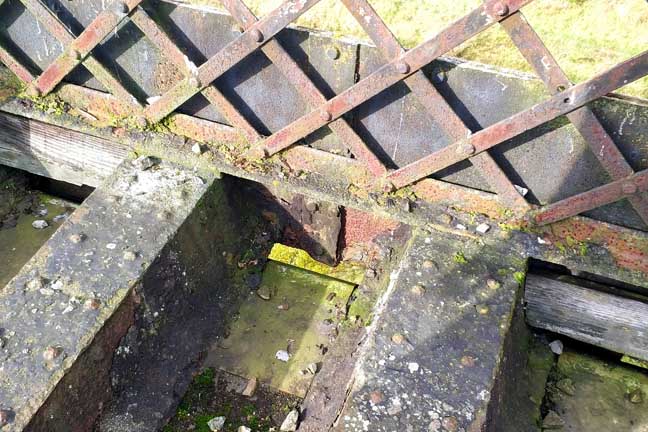
The paintwork is peeling, but Bennerley remains structurally sound. Photo: Alun Taylor
A survey of the viaduct in 2016 found the structure to be fundamentally sound. Despite the paintwork long since wearing away, frost and plant damage wreaking havoc on the brickwork that surrounds the footings, omnipresent rust and the last maintenance work done almost half a century ago, Bennerley Viaduct stands strong as a testament to the essential quality of Victorian engineering.
A surprising revelation of the survey was that while the quality of the wrought iron was found to be inconsistent, the trapping of impurities through the manufacturing process has had the effect of providing a higher corrosion resistance than anticipated.
Less shockingly the survey found that the trough ends had corroded and there had been some oxide jacking between plates. Rivets are missing (although there are almost half a million of them still in place) and many of the pier bases have lost brickwork due to freeze/thaw action and tree growth.
The inspiration for the overall design of Bennerley was reputedly the similarly sized 1864 Busseau-sur-Creuse viaduct in central France, designed by Wilhelm Nördling. This is by no means impossible. The two viaducts share a common lattice-girder and Warren-pier design and its engineer was an Englishman, Francis Lloyd.
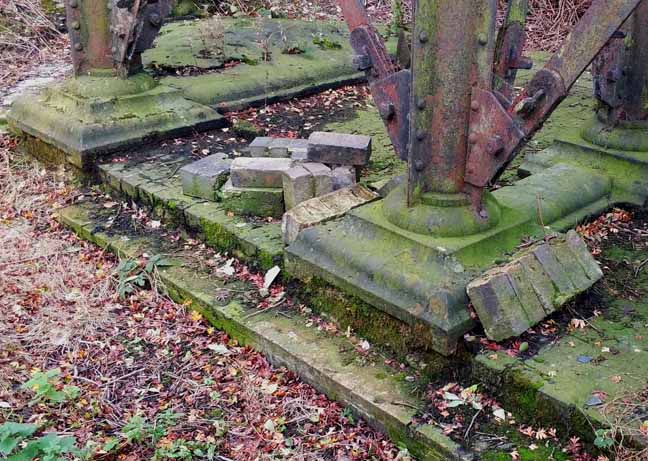
Bennerley's iron legs rely on brick and concrete feet. Photo: Alun Taylor
The Busseau viaduct is often spuriously credited to Gustave Eiffel. A 1979 report by the Arkwright Society advocating the preservation of the Bennerley Viaduct mentions the bridge's possible role in the evolution of the technology that led to Eiffel's famous Paris landmark built in 1887-9.
Sadly the idea that Bennerley Viaduct directly led to the Eiffel Tower rather than simply sharing a construction method seems to have no more substance to it than the curious story that it was built by German convict labour.
The easy availability to local ironwork also played a part in the choice of construction technique. Using its 39 puddling furnaces, Derby-based Eastwood, Swingler & Co. prefabricated the ironwork at its base a mere 13 miles away. The construction company, Benton & Woodiwiss, was similarly Derby-based.
The viaduct enjoyed a remarkably event-free life between its opening on 28 January 1878 and its final closure as a goods line just over 90 years later on 6 May 1968. Passenger services had stopped four years previously.
A singular exception occurred on the night of January 31, 1916, when a fleet of nine German Zeppelin airships crossed the North Sea heading for Manchester and Liverpool only to get lost in fog.
One of the airships commanded by Kapitänleutnant Franz Stabbert spotted the glow from the furnaces of the Bennerley Ironworks situated north of the viaduct. Several bombs were dropped, one narrowly missing the structure but flattening the nearby signal box.
One of the cross bars on the viaduct has a 2cm chunk missing from it, popularly surmised to have been caused by shrapnel from this near-miss. I can offer no better explanation. Clearly something solid travelling at a very high velocity has clipped the bar.
Those times are gone now, along with the rail traffic that once thundered across this gentle giant. Work, however, is now under way to reopen the viaduct to a more contemporary mode of transport – the bicycle. Ownership of Bennerley transferred from the British Rail Property Board in 1998 to sustainable transport charity Sustrans as part of a portfolio, which included 210 miles of disused railway routes.
It was Sustrans' intention to repurpose the viaduct as part of the National Cycle Network with the help of the Heritage Lottery Fund. The renovation of the viaduct was anticipated to take four years and cost around £7.5m with £4.5m of that coming from lottery funding. The project even had the support of local politicians.
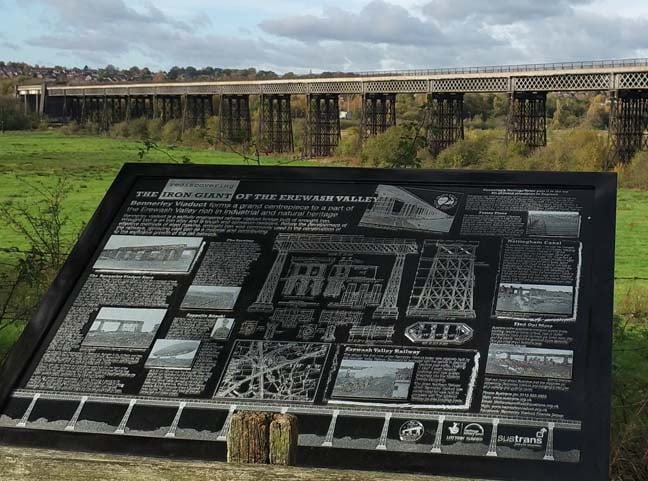
Bennerley Viaduct and its surroundings are foot and bike friendly. Photo: Alun Taylor
In December 2017 Sustrans' funding application was denied and in February 2018 Sustrans said it would not resubmit the proposal and would no longer be pursuing the project. Sadly, at the time of writing, the future of this great survivor is once again in the lap of the gods.
If and until such time as Bennerley is restored and reopened, you can park up and explore this remarkable statement of Victorian ingenuity.
In the meantime, you can help out as a volunteer. The Friends of Bennerley Viaduct regularly organise work days. You can find more details on their website.
It's worth a few hours touring, marvelling or pitching in.
Bennerley is a short hop from Derby, Nottingham or Mansfield with the closest urban stop-off being Ilkeston. This bustling market town hosts a number of attractive cafes and tea rooms. Ilkeston is handily just off the M1 – junction 25. You can continue the industrial theme at the nearby Nottingham Industrial Museum or divert to Wollaton Hall, Gardens and Deer Park and the Attenborough Nature Reserve.
There is no shortage of places to stay or eat in the area but I must mention the Bridge Inn, Ilkeston, a traditional canal-side boozer a few minutes walk from the western edge of the viaduct. I found both the food and beer to be excellent.
Not a bad place to spend a few hours, caught up in the power and complexity of this Victorian iron wonder. ®
GPS
52.988776, -1.299691
Postcode
NG16 2BF
Getting there
By car: Take the M1 to Junction 26 then follow the A610 to Eastwood then the A6096 for Ilkeston. There is a small car park by the Naptha boarding kennels. By train: From London St, Pancras, Kings Cross, Leeds, Nottingham, Liverpool Lime Street to Ilkeston station, which reopened in 2017. The viaduct is a 2.57km (1.6 mile) walk or bike ride via the Erewash Valley Cycle Trail.
